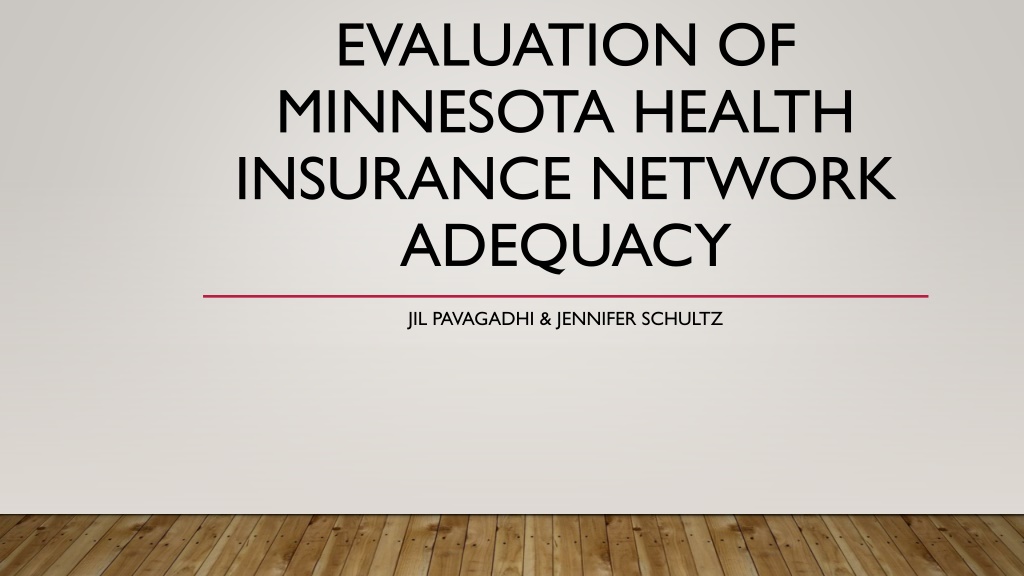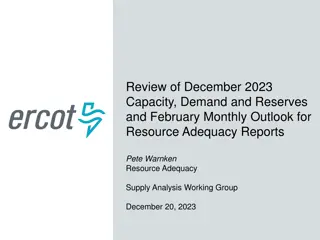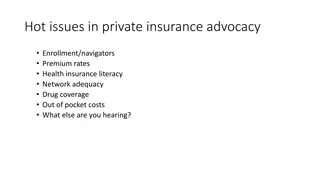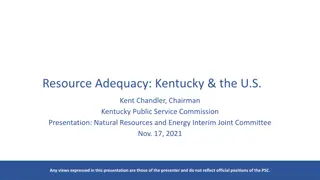Evaluation of Minnesota Health Insurance Network Adequacy Study
The evaluation assessed the network adequacy of health insurance in Minnesota, focusing on specific provider specialties and types. Results showed that about 41% of plans were considered insufficient, with key providers lacking in certain specialties. The approach involved data standardization, analysis of 37 insurance plans, and mapping out provider locations with precision. The research objective aimed to provide valuable information to Minnesota agencies and legislatures for improvement.
Download Presentation

Please find below an Image/Link to download the presentation.
The content on the website is provided AS IS for your information and personal use only. It may not be sold, licensed, or shared on other websites without obtaining consent from the author. Download presentation by click this link. If you encounter any issues during the download, it is possible that the publisher has removed the file from their server.
E N D
Presentation Transcript
EVALUATION OF MINNESOTA HEALTH INSURANCE NETWORK ADEQUACY JIL PAVAGADHI & JENNIFER SCHULTZ
BACKGROUND US spends 17% of the GDP on health care, approximately $3 trillion Minnesota spent about $39.8 billion in 2012 (MN Dept. of Health) Access is limited to persons with Insurance through employer/ exchange Government sponsored program Private insurance/ care Safety-net provider
BACKGROUND Narrow Network plans are becoming popular (50% of marketplace offerings) Drive down overall cost of healthcare Lower premiums Plans too narrow to offer care in a timely manner with additional issues (22%) Decreasing over time (2015- 15 Networks 2017- 12 Networks) Minnesota geographic access standards 30 minutes/miles for primary care, mental health, & general hospital services Waiver
RESEARCH OBJECTIVE To evaluate the health insurance network adequacy in Minnesota for specific Provider Specialties (child psychiatry, psychiatry, neuropsychology, mental health nurse practioner & mental health clinical nurse specialist ) and several Provider Types (licensed independent clinical social worker, licensed psychologist, licensed professional clinical counselor (LPCC), chemical dependency provider- inpatient/outpatient). The results will provide information to MN agencies & legislatures
APPROACH Data standardization and analysis 37 insurance plans offered in 2017 Excel Mapped and drew out 30 min/mile polygons 700- 78,000 provider locations per plan With about 98-100% precision ArcGIS
RESULTS ~41% of plans are insufficient (15/37) HealthPartners, Medica, Sandford Health Most of them had spec 21 and 81 not available licensed indp clinical social worker licensed clinical counsel or chemical depend provider- inpatient chemical depend provider- outpatient child psychi atry neurop sycholo gy, mental health NP licensed psychol ogist psychi atry AVG GSG Gundersen Small Group HPI Open Access Network 0.0 60.5 0.0 64.5 0.0 61.7 63.8 28.9 64.4 38.2 95.8 99.2 74.9 97.7 99.9 100.0 99.5 97.1 99.9 96.0
CONCLUSION First time, cross checked by a third party Network inadequacy clearly visible Concern for patients and families with out adequate access to care Networks are becoming more narrow Possible reasons: Insufficient mental health providers in Minnesota? Plans are not adequately reimbursing providers and thus providers are not participating in networks.
FUTURE WORK Dental providers Other specialty & provider types Improve network adequacy requirements Audit carriers What specialty or provider type do you recommend researching next?
REFERENCES http://www.health.state.mn.us/divs/hpsc/hep/publications/costs/healthspending2014.pdf http://www.health.state.mn.us/divs/hpsc/mcs/networkadequacy.htm http://www.ncsl.org/research/health/insurance-carriers-and-access-to-healthcare- providers-network-adequacy.aspx http://www.house.leg.state.mn.us/comm/docs/cf5f0d04-f6e5-449c-9533- 402bd2a20256.pdf























